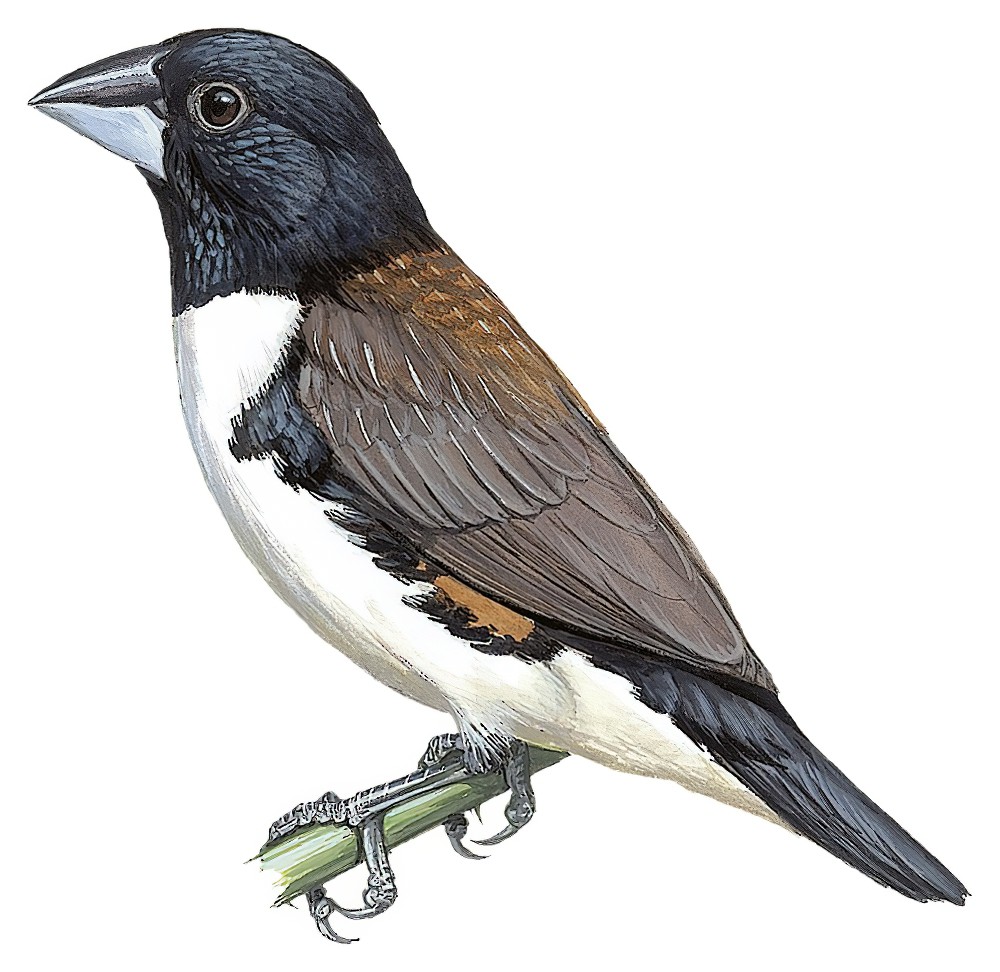Magpie Mannikin / Spermestes fringilloides

Magpie Mannikin
SCI Name:
Protonym: Plocus fringilloides Mag.Zool. 5 cl.2 pl.48
Taxonomy: Passeriformes / Estrildidae / Spermestes
Taxonomy Code: magman1
Type Locality: India ; emended to Liberia by Hartlaub, 1857, Syst. Ornith. Westafrika, p. 147.
Author: Lafresnaye
Publish Year: 1835
IUCN Status: Least Concern
DEFINITIONS
SPERMESTES
(Estrildidae; Ϯ Bronze Mannikin S. cucullata) Gr. σπερμα sperma, σπερματος spermatos seed < σπειρω speirō to scatter; -εστης -estēs
-eater < εδω edō to eat; "BRONZE-HOODED BENGALY. Spermestes cucullata, SWAINS. ... On comparing the structure of this bird with the last [Vidua chalybeata], we find that the base of the under mandible is thicker than that of the upper, and that the hind-toe is as long as the tarsus. We have been told that most of these little Bengalies feed upon the hard seeds of the African millet, and some other of the tall grasses, or rather reeds, so common in the swamps of that country; this fact is in unison with the hardness of their bill, while the structure of their large slender feet and claws is precisely that most adapted to secure a hold or footing on smooth and upright stems." (Swainson 1837 (Nat. Hist. Birds Western Africa, I, 201)); "Spermestes, Sw. Bill short, thick. Feet very large. Toes and claws long and slender. Tail short, even. Chiefly India. S. cucullata. West. Af. i. 201" (Swainson 1837 (Nat. Hist. Classif. Birds, II, 280)); "Spermestes Swainson, 1837, Birds W. Africa, 1, p. 201. Type, by monotypy, Spermestes cucullata Swainson." (Traylor in Peters 1968, XIV, 369).
Var. Spernistes, Spernistis.
Synon. Amauresthes, Pseudospermestes, Stictospermestes.
fringilloides
L. fringilla finch; Gr. -οιδης -oidēs resembling.
● Specific name Accipiter fringillarius Eyton, 1836 (= syn. Accipiter nisus); Gr. -οιδης -oidēs resembling; "2. ACCIPITER FRINGILLOIDES. Acc. supra cinereo-griseus, subtus albus brunnescente-fusco graciliter fasciatus, rectricibus fasciis quinque saturate fuscis. ... I find no description in any author which exactly corresponds with this delicate Sparrow Hawk. ... Our bird is a genuine Accipiter, and typical in the group." (Vigors 1827) (subsp. Accipiter striatus).
● "5. TACHYPHONUS fringilloides. Sp. Nov. T. supra cinereus, infra albens, cristæ coccineæ, marginibus lateralibus nigris; rostro brevi, conico. ... In the shortness and compression of the bill it agrees with T. rubescens; but the tail, which in that bird is nearly, if not quite, even, in this is more rounded; the feathers likewise are broader. The margins of the bill are inflexed, but not sinuated; and the acute angle, which constitutes a very prominent character in the Fringillæ, is wholly wanting in both these birds." (Swainson 1825) (syn. Coryphospingus pileatus).
● "70. MONTIFRINGILLA FRINGILLOIDES (Boie) (nivalis, auctt.). Fringilla nivalis, Severtzoff, p. 64." (Dresser 1875) (syn. Montifringilla nivalis alpicola).
● "TISSERIN. PLOCUS [sic]. Cuvier. T. FRINGILLOÏDE. P. fringilloides. Lafresnaye. Nous avons cru devoir donner à cette nouvelle espèce de Tisserin le nom de Fringilloïde, parce que, si d'un côté la forme robuste et longicône de son bec la place évidemment dans les Tisserins, d'autre part la couleur de son plumage, entièrement conforme à celle de plusieurs espèces de Gros-Becs ou Fringilles de l'Inde, sa patrie, et distincte de celles de toutes les espèces de Tisserins connus jusqu'alors ... Le nom de Tisserin ou Tisserand semble ne devoir appartenir qu'à certains Conirostres, voisins de nos moineaux, qui ont l'habitude de tisser leurs nids avec plus ou moins d'art, en entrelaçant des brins d'herbe sèche." (de La Fresnaye 1835) (Spermestes).
● "8. Oryzoborus fringilloides Pelzeln. N. 1037 (754) n. sp.? Fringilla sp. Natterer Catal. msc. ... Oryzoborus? fringilloides Pelzeln. N. 1037 (754). Femina. Cinnamomeo brunnea, gula, medio pectoris inferioris et abdominis rufescente albis, rostro illi O. unicoloris simili elongato fringillaceo, et pedibus obscure cinereis. ... Fringilla sp. Natterer Catal. msc. Hab. Rio Xiè." (von Pelzeln 1870) (Sporophila).
Fringilloides
(Emberizidae; syn. Emberiza † Black-headed Bunting E. melanocephala) Genus Fringilla Linnaeus, 1758, finch; Gr. -οιδης -oidēs resembling; "a very peculiar group of buntings, which I, for their long, large, conical beak, resembling the beak of finches (Fringillidae), suggest the name Fringilloides gen. nov. (type: Emberiza melanocephala)" (Buturlin 1910) (transl. and OD per Laurent Raty); "Fringilloides Buturlin, 1910, Nasha Okhota, 4 (1), p. 119. Type, by original designation, Emberiza melanocephala Scopoli, 1769." (JAJ 2021).
UPPERCASE: current genus
Uppercase first letter: generic synonym
● and ● See: generic homonyms
lowercase: species and subspecies
●: early names, variants, mispellings
‡: extinct
†: type species
Gr.: ancient Greek
L.: Latin
<: derived from
syn: synonym of
/: separates historical and modern geographic names
ex: based on
TL: type locality
OD: original diagnosis (genus) or original description (species)












